बोफर्ट मापक्रम

बोफर्ट मापक्रम (Beaufort scale) पवनवेग और समुद्र तथा स्थल की दशाओं के बीच सम्बन्ध बताने वाला एक आनुभविक (इम्पिरिकल) तालिका है। इसका पूरा नाम 'बोफर्ट पवनवेग मापक्रम' (Beaufort wind force scale) है। यह मापक्रम 1805 में फ्रांसिस बोफर्ट (Francis Beaufort) द्वारा सुझाया गया था। वे जो आयरिश रॉयल नेवी में अफसर थे।
आधुनिक स्केल[संपादित करें]
| बोफर्ट संख्या | विवरण | पवन वेग | तरंग ऊँचाई | समुद्र की दशा | स्थल की दशा | समुद्र की दशा का फोटो | संबन्धित चेतावनी ध्वज |
|---|---|---|---|---|---|---|---|
| 0 | प्रशान्त (Calm) | < 1 km/h | 0 m | समतल | धुआँ सीधा उठता है। | 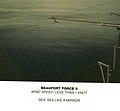 |
|
| < 1 mph | |||||||
| < 1 knot | 0 ft | ||||||
| < 0.3 m/s | |||||||
| 1 | हल्की वायु (Light air) | 1.1–5.5 km/h | 0–0.2 m | Ripples without crests. | धुएँ में हलचल होती है और वह हवा की दिशा दिखाता है। Leaves and wind vanes are stationary. | 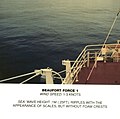 |
|
| 1–3 mph | |||||||
| 1–3 knot | 0–1 ft | ||||||
| 0.3–1.5 m/s | |||||||
| 2 | अल्प समीर (Light breeze) | 5.6–11 km/h | 0.2–0.5 m | Small wavelets. Crests of glassy appearance, not breaking | Wind felt on exposed skin. Leaves rustle. Wind vanes begin to move. | 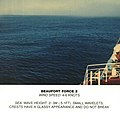 |
|
| 4–7 mph | |||||||
| 4–6 knot | 1–2 ft | ||||||
| 1.6–3.4 m/s | |||||||
| 3 | मंद समीर (Gentle breeze) | 12–19 km/h | 0.5–1 m | Large wavelets. Crests begin to break; scattered whitecaps | पत्ते और छोटे तने लगातार हिलते हैं। ध्वज फैल जाता है। |  |
|
| 8–12 mph | |||||||
| 7–10 knot | 2–3.5 ft | ||||||
| 3.5–5.4 m/s | |||||||
| 4 | अल्पबल समीर (Moderate breeze) | 20–28 km/h | 1–2 m | Small waves with breaking crests. Fairly frequent whitecaps. | धूल और फटे हुए कागज उड़ने लगते हैं। छोटे साखा हिलने लगते हैं। |  |
|
| 13–17 mph | |||||||
| 11–16 knot | 3.5–6 ft | ||||||
| 5.5–7.9 m/s | |||||||
| 5 | सबल समीर (Fresh breeze) | 29–38 km/h | 2–3 m | Moderate waves of some length. Many whitecaps. Small amounts of spray. | Branches of a moderate size move. Small trees in leaf begin to sway. |  |
|
| 18–24 mph | |||||||
| 17–21 knot | 6–9 ft | ||||||
| 8.0–10.7 m/s | |||||||
| 6 | प्रबल समीर (Strong breeze) | 39–49 km/h | 3–4 m | Long waves begin to form. White foam crests are very frequent. Some airborne spray is present. | Large branches in motion. Whistling heard in overhead wires. Umbrella use becomes difficult. Empty plastic bins tip over. | 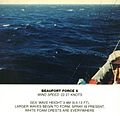 |

|
| 25–30 mph | |||||||
| 22–27 knot | 9–13 ft | ||||||
| 10.8–13.8 m/s | |||||||
| 7 | अल्पबल झंझा (moderate gale), (near gale) |
50–61 km/h | 4–5.5 m | Sea heaps up. Some foam from breaking waves is blown into streaks along wind direction. Moderate amounts of airborne spray. | Whole trees in motion. Effort needed to walk against the wind. |  |

|
| 31–38 mph | |||||||
| 28–33 knot | 13–19 ft | ||||||
| 13.9–17.1 m/s | |||||||
| 8 | झंझा (fresh gale) |
62–74 km/h | 5.5–7.5 m | Moderately high waves with breaking crests forming spindrift. Well-marked streaks of foam are blown along wind direction. Considerable airborne spray. | Some twigs broken from trees. Cars veer on road. Progress on foot is seriously impeded. |  |
 
|
| 39–46 mph | |||||||
| 34–40 knot | 18–25 ft | ||||||
| 17.2–20.7 m/s | |||||||
| 9 | प्रबल झंझा (Strong gale) |
75–88 km/h | 7–10 m | High waves whose crests sometimes roll over. Dense foam is blown along wind direction. Large amounts of airborne spray may begin to reduce visibility. | Some branches break off trees, and some small trees blow over. Construction/temporary signs and barricades blow over. | 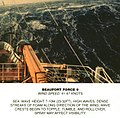 |
 
|
| 47–54 mph | |||||||
| 41–47 knot | 23–32 ft | ||||||
| 20.8–24.4 m/s | |||||||
| 10 | तूफान (Storm),[1] whole gale |
89–102 km/h | 9–12.5 m | Very high waves with overhanging crests. Large patches of foam from wave crests give the sea a white appearance. Considerable tumbling of waves with heavy impact. Large amounts of airborne spray reduce visibility. | Trees are broken off or uprooted, structural damage likely. | 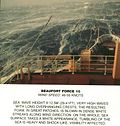 |

|
| 55–63 mph | |||||||
| 48–55 knot | 29–41 ft | ||||||
| 24.5–28.4 m/s | |||||||
| 11 | तीव्र तूफान (Violent storm) |
103–117 km/h | 11.5–16 m | Exceptionally high waves. Very large patches of foam, driven before the wind, cover much of the sea surface. Very large amounts of airborne spray severely reduce visibility. | Widespread vegetation and structural damage likely. | 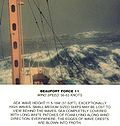 |

|
| 64–73 mph | |||||||
| 56–63 knot | 37–52 ft | ||||||
| 28.5–32.6 m/s | |||||||
| 12 | प्रभंजन (Hurricane force)[1] |
≥ 118 km/h | ≥ 14 m | Huge waves. Sea is completely white with foam and spray. Air is filled with driving spray, greatly reducing visibility. | Severe widespread damage to vegetation and structures. Debris and unsecured objects are hurled about. |  |
 
|
| ≥ 74 mph | |||||||
| ≥ 64 knot | ≥ 46 ft | ||||||
| ≥ 32.7 m/s |
सन्दर्भ[संपादित करें]
- ↑ अ आ The names "storm" and "hurricane" on the Beaufort scale refer only to wind strength, and do not necessarily mean that other severe weather (for instance, a thunderstorm or tropical cyclone) is present. To avoid confusion, strong wind warnings will often speak of e.g. "hurricane-force winds".
